Population Growth and Regulation
I. Definitions and domain of ecology
A. What ecology is not.
B. Definitions.
1. Haeckel (1869): the scientific study of the interactions between
organisms and their environment
2. Krebs (1972): ecology is the scientific study of the interactions
that determine the distribution and abundance of organisms.
C. Ecology overlaps with evolution.
D. Ecology encompasses a very large scale.
1. Scale is a continuum.
a. Individuals
b. Populations
c. Communities
d. Ecosystems
e. Biogeography
II. Definition of a population: a group of individuals of a species within
a given area.
1. Boundaries of a population can be natural ones, or arbitrary, if defined
by an investigator.
2. Populations have spatial structure: individuals live primarily within
patches of suitable habitat.
III. Population growth.
A. Understanding dynamics of population growth important to wildlife
managers, integrated pest management, conservation biology.
B. A general equation for unregulated (exponential) population growth.
1. Discrete generations. Start with population of 10 individuals (N0),
all individuals produce 2 offspring and then die.
General eq: 
2. Continuous processes more common where generations overlap (individuals
breed in multiple years or throughout the year). Use rate of increase represented
by a differential equation.

a. r is the rate at which the population increases in size, i.e., the
change in population size per individual per unit time or the per-capita
rate of population growth [dN/dt *1/N = r = the average rate of increase
per individual]. r represents the difference between the per capita birth
rate and the per capita death rate.
b. if r > 0, + rate of change, population increases; whereas if r
< 0, negative rate of change, population decreases.
c. r is useful for making comparisons among various populations of the
same species in different environments to see which environment appears
to be the most favorable.
3. Future population size of an exponential growing population can be
determined in terms of initial integrating:

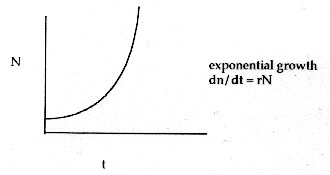
4. Do populations grow exponentially? Yes! But not indefinitely. What
causes limits on exponential growth?
C. Regulated (logistic) population growth.
1. Background.
2. They reasoned that r decreases with population size

a.  is the intrinsic rate of increase when population size
is growing exponentially when population size is very small.
is the intrinsic rate of increase when population size
is growing exponentially when population size is very small.
b. K is the carrying capacity of the population or the number of individuals
the environment can support.
c. 1-N/K is a dampening term.
i. If N<<K then r remains large, but as N = K, r becomes small.
3. Add dampening term to differential equation describing exponential
growth to obtain the logistic growth equation.
Logistic growth equation: 
4. Time course found by integrating logistic growth equation:

where  , a constant depending on the starting population size
, a constant depending on the starting population size
5. The logistic growth equation produces a sigmoidal curve. Population
growth slow at first, then accelerates, and finally slows as population
size approaches K.

Examples of yeast, sheep.
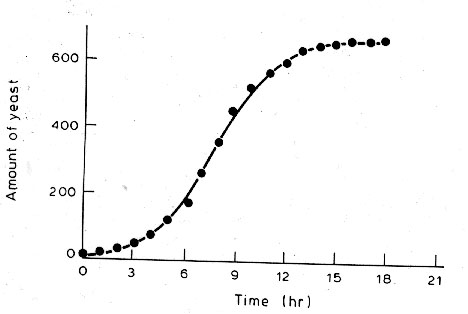
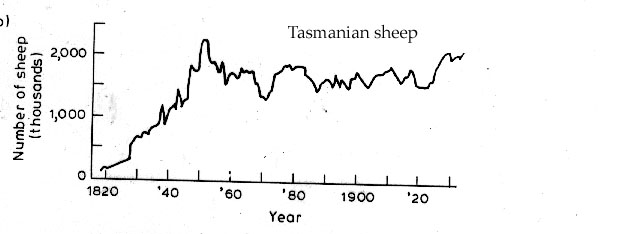
D. Harvesting natural resoures
1. The inflection point of the logistic growth equation represents the
point of maximum population growth. The population size at this point can
be found by plotting the rate of growth vs population size.

2. In theory maximum harvest can occur at the maximum rate of recruitment
(i.e. the maximum of dN/dt). This point is known as the maximum sustainable
yield (MSY).
a. At MSY, population is growing at maximum and can (theoretically)
compensate for harvesting as long as harvesting is done at this level or
below.
b. MSY is a dominant concept in resource managment and once calculated
has been used to establish fixed quotas.
c. Use of MSY and other ways of fixing quotas has not been successful,
especially in harvesting fisheries and other marine resources. Two examples:
Peruvian anchoveta and whaling.
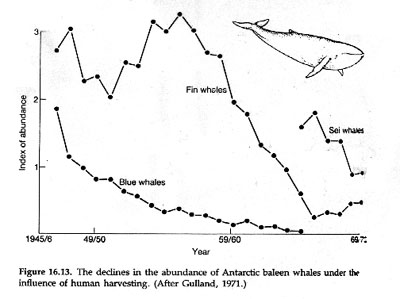
E. Why does resource management fail?
1. Limitations of logistic growth curve. The logistic growth curve offers
insight into how populations grow, but it includes several key assumptions
that may not be valid in all populations. This does not mean that the logistic
growth model is useless--it means that agencies and managers using it need
to consider how these assumptions may affect MSY.
2. Assumptions of the logistic growth curve.
a. The relation between density and the rate of increase is linear.
b. The effect of density on rate of increase is instantaneous.
c. The environment (and thus K) is constant.
d. All individuals reproduce equally.
e. There is no immigration or emigration.
3. Why these assumptions are not always realistic.
a. In nature, each individual added to the population probably does
not cause an incremental decrease to r.
b. In nature there are often time lags, especially in species with complex
life cycles. For example, nestling Tree Swallow survival affects the number
in the breeding population in the subsequent year.
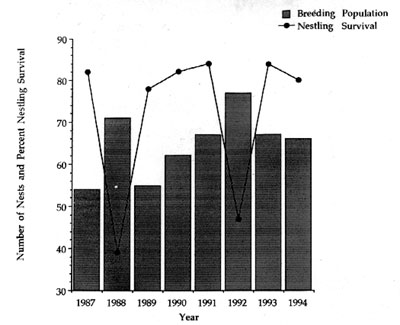
c. In nature, K may vary seasonally or with climate. In Daphnia, population
dynamics change at different temperatures.
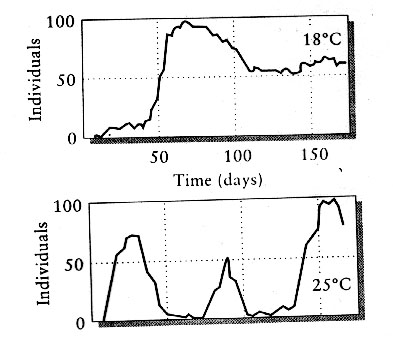
d. In nature, often a few individual command many matings.
e. In nature, there are few barriers preventing dispersal.
4. Harvest quotas need to reflect the fact that populations are dynamic
(changing). Monitoring recruitment directly and using more complex models
are ways that managers are using to set more conservative quotas
5. But non-sustainable harvesting practices are not always changed even
when extinction looms due to political and economic pressures.
![]()
![]()
![]()







